
|
|

May 21 & 28, 2010
(We're taking Memorial Day weekend off...back with a new installment Friday, June 4!)
WAGA-TV and WDWD, Atlanta, 2009
There are some cities where it's our habit to visit in a leisurely fashion; later this summer, for instance, we'll be spending the better part of a week in Boston, mixing radio fun with some of our other hobby interests. Then there are cities that, for whatever reason, seem to prompt a rush of activity. Later this year here on Site of the Week, you'll see the results of a whirlwind two-day train trip from Rochester to Chicago last June to see that market's analog TV just days before it went away.
 Another
market that always seems to get jam-packed with activity for
us is Atlanta. Maybe it has something to do with the often dirt-cheap
plane tickets that make it easy for a quick getaway, or maybe
it's something about the friendly radio folks who go out of their
way to show off the market - but in any event, our February 2009
trip to Atlanta was another nonstop whirl of studios and transmitter
sites, much like our last two-day visit back in 2004 (chronicled
here
and in three previous 2005 installments.)
Another
market that always seems to get jam-packed with activity for
us is Atlanta. Maybe it has something to do with the often dirt-cheap
plane tickets that make it easy for a quick getaway, or maybe
it's something about the friendly radio folks who go out of their
way to show off the market - but in any event, our February 2009
trip to Atlanta was another nonstop whirl of studios and transmitter
sites, much like our last two-day visit back in 2004 (chronicled
here
and in three previous 2005 installments.)
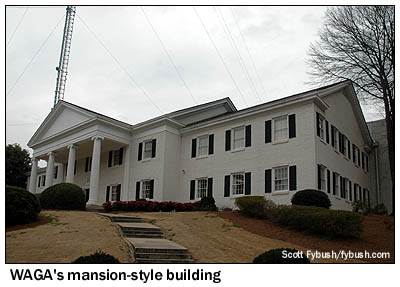
Even on a tightly-packed two-day tour like this one, there's always room for one more tour if a good opportunity presents itself, and so it did near the end of our second day, when a last-minute phone call yielded a late-afternoon impromptu tour of one of Atlanta's biggest and oldest TV stations.
WAGA-TV (Channel 5) wasn't the first station in town - that honor belonged to WSB-TV (then on channel 8), which signed on in September of 1948 - but it wasn't far behind, debuting on March 8, 1949 from a studio and transmitter site (complete with a 499-foot self-supporting tower) at 1018 West Peachtree Street, just north of downtown Atlanta.
Storer Broadcasting already owned radio stations in Atlanta: WAGA (590) and WAGA-FM (103.3) were the city's CBS radio affiliates, so it was inevitable that WAGA-TV would follow suit, becoming the CBS-TV affiliate, with secondary connections to ABC and DuMont, at least for its first few years.
The city's growth in the 1950s made a bigger signal a necessity, and in 1955 Storer bought land northeast of downtown, in the Druid Hills neighborhood near the WAGA(AM) tower site, building an 1100-foot tower to dramatically boost channel 5's reach.
A decade later, the studios followed the transmitter out to Druid Hills, where Storer built what can only be described as a classic Storer studio building. Wherever Storer built studios, whether it was WHN in Manhattan or WSPD in Toledo or WJBK in Detroit or WSBK in Boston, the style was always the same: Southern antebellum mansion. And if the style didn't quite fit alongside the Massachusetts Turnpike or Ten Mile Road in Southfield, it fit perfectly at 1551 Briarcliff Road NE.
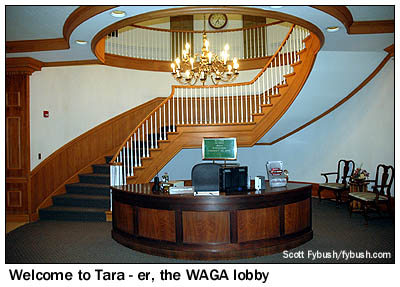
|
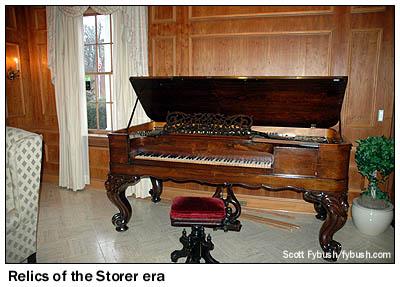
|
WAGA-TV has been through plenty of changes since this building was dedicated in January 1966. A series of sales following Storer's exit from broadcasting in the mid-80s eventually landed channel 5 in the hands of New World Communications, which in turn led to an affiliation change in 1994 that flipped WAGA to Fox. (CBS moved to what was then WGNX-TV, channel 46, while former Fox outlet WATL-TV 36 went independent.)
In 1997, Fox swallowed New World, making WAGA an owned-and-operated station - and one of the most successful Fox outlets in the country, routinely leading every station in the market except the massively dominant WSB-TV in the ratings.
And it's with that background that we walk up to the front porch and into the wood-paneled lobby, where it's still Storer-ville, circa 1966, complete with fancy furniture and, yes, a player piano in the corner. The layout of the building is interesting indeed: the "mansion" that faces Briarcliff Road is only a small part of what's actually a very big building that sprawls out to the rear. The front portion houses the administrative and programming offices, which have retained much of their Storer-era character. The rear portion, offset by half a floor from the front, is where the guts of the station sit - and where most of the change since 1966 has taken place.
Our tour starts on the north side of the building, where the original 1955 transmitter building was incorporated into the big 1966 expansion. Our visit in February 2009 came at the very end of analog channel 5, which was then being broadcast from a relatively recent Larcan solid-state transmitter occupying one side of the old transmitter room, next to the much older RCA that was still capable of being fired up as a backup. (The Larcan would get a starring role a few months later on the last night of WAGA's analog transmission, when 99-year-old former chief engineer Paul Cram, who'd turned WAGA-TV on in 1949, returned to the station to turn off the channel 5 signal for good; as with everything else in the world, the clip is of course available for your enjoyment on YouTube...)
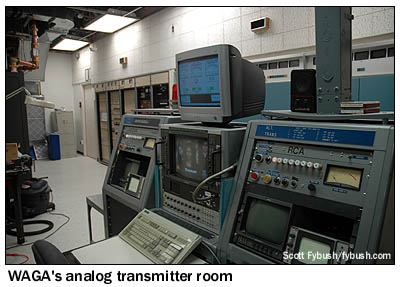
|
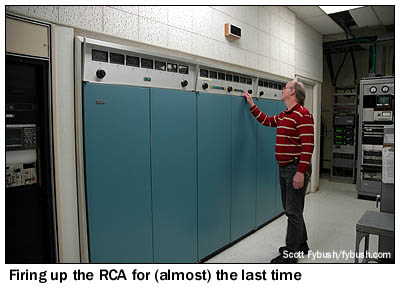
|
WAGA-DT remained on its transitional digital channel, 27, and that signal comes from another room adjacent to the old analog transmitter room. That's where we see the big Comark digital transmitter and, back on the wall behind it, a smaller Larcan transmitter that's now the backup digital transmitter.
The digital signals (and, until last year, the analog) go out of here to an 1144-foot candelabra tower at the north end of the property, which went up in 2000 to replace the original 1955 tower. The base of that old tower can still be seen next to an equipment building behind the old transmitter room.

|

|
As neat as the transmitters are, there's much more to be seen in this building, and with the start of the 5 PM news fast approaching, our next stop, just past a big engineering workshop half a flight of stairs down from the transmitter room, is the news studio at the back of the building.

|

|
Our 2009 visit found WAGA at a moment of big transition in its news production: the old SD control room around the corner from the news studio was in its final days, with rehearsals already underway in the new HD control room that had been carved out of channel 5's other, smaller, studio space.

|

|
From here, the building would be less and less recognizable to a time-traveler from 1966, since it's been expanded on the south side to provide much more room for the sales department and for a much-expanded newsroom. (WAGA's original newsroom was on the first floor of the "mansion," in space that's now used by the station's investigative reporters and the sports department.)
And master control, which was over by the transmitter in 1966, now occupies a much more modern space down on the ground floor.

|

|
We've left one piece of this puzzle out, and that's the fate of WAGA radio.
Back to the history books we go, to note that WAGA began on 1450 kilocycles in the late 1930s, moved briefly to 1480 in the big NARBA shuffle of 1941, then moved again in 1946 to 590.
(The 1480 frequency was later reused by a new station, WYZE, that had no connection to WAGA, no matter what Wikipedia may try to tell you.)
Storer sold off WAGA radio in 1959, and new owner Plough Inc. changed the calls to WPLO, a callsign that would quickly become synonymous with high-energy top-40 music in Atlanta, then even more closely tied to the country format that arrived at 590 in the mid-sixties.
WPLO lasted into the eighties, but its transmitter site on Druid Hills Road did not; it was developed for an apartment complex, and in 1986 the AM 590 signal was relocated up to Powder Springs, in Cobb County northwest of Atlanta. The new 590 site used four towers to beam 5 kilowatts, day and night, back into Atlanta - but it never matched up to the big in-city signal from the old Druid Hills site, and AM 590 eventually settled into obscurity as the AM simulcast of country station WKHX-FM (101.5 Marietta).
(What about the old WPLO-FM 103.3? It changed ownership too, separating from 590 and becoming WVEE, a sister station to the venerable WAOK 1380.)
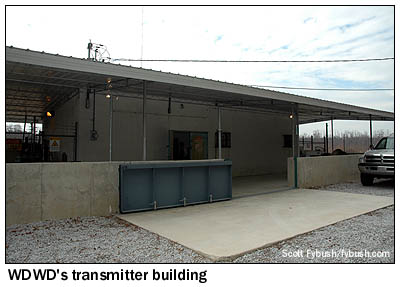
|

|
In 1997, 590 flipped again, trading the WKHX(AM) calls for WDWD. That's "WD" for "Walt Disney," parent company of then-owner ABC Radio - and of course namesake of Radio Disney, which has been heard on 590 ever since.
When we paid a call on the Powder Springs site in 2009, WDWD was just in the final stages of a daytime power increase to 12 kW, which meant a new Nautel XR12 transmitter to replace the AMPFET that had been out here since the site was new. Notice that the Nautel was up on a platform - and then notice the floodwall around the building and the sliding gate that could seal it off if the waters of nearby Noses Creek started to rise.
Alas, all that emergency preparedness was no match for the deluge that hit the Atlanta area in the fall of 2009. The waters rose above the floodwall and right into - and then right over - the building. At the height of the flooding, only the peak of the transmitter-building roof poked up above the muddy water. WDWD was off the air for a week, but much of the equipment was saved, and it was soon dried out and back on the air after some very impressive hard work by contract engineer Russell Smith and his crew.
This Tower Site of the Week installment comes with audio over at TopHour.com, where you can hear a whole bunch of 2009 IDs from Atlanta - and in the meantime, we urge you not to miss your chance to grab one of the dwindling remaining stash of the all-new Tower Site Calendar 2010, just in time to fill that space on the wall where your 2009 edition once hung.
 (It's
more than just pretty pictures and dates - the modest sum we
raise from each year's calendar helps make possible the travel
needed to make this feature happen every week on the website...and
we're grateful for all your support!)
(It's
more than just pretty pictures and dates - the modest sum we
raise from each year's calendar helps make possible the travel
needed to make this feature happen every week on the website...and
we're grateful for all your support!)
- Previous Site of the Week: Atlanta, 2009, part II
- In Two Weeks: Atlanta, 2009, part IV
- Site of the Week INDEX!
- How can you help support Site of the Week? Click here!
- Submit your suggestions for a future Site of the Week!
